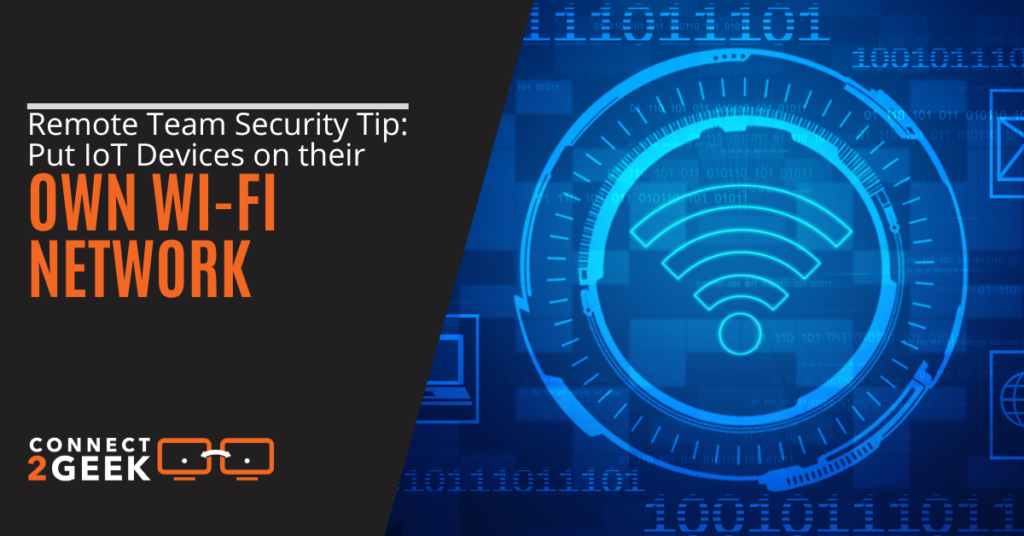
Most companies have now settled into the flow of having remote workers. Since the pandemic, remote work and hybrid teams have become the new normal. But when it comes to cybersecurity, companies are still figuring a few things out.
Having company data accessed and transmitted through multiple home networks leaves them at greater risk of a cyberattack.
Unfortunately, hackers have remote teams squarely in their sights to target. Sixty-five percent of IT and security professionals say it is easier to protect company data when everyone is working in the same place, and 64% worry about the security of remote workers.
During the first year of the pandemic, 50% of surveyed organizations reported having a cybersecurity incident.
Unlike office networks, home networks are often sharing a Wi-Fi channel with much less secure devices, such as a voice assistant, smart appliance, or other IoT (Internet of Things) devices.
IoT devices have more vulnerabilities, making them easier to breach. One way to counteract this is to have your work-from-home staff put their IoT devices in a separate Wi-Fi network than computers and mobile devices with access to work data.
Why Put IoT Devices on a Separate Wi-Fi Network?
IoT Devices Are Less Secure Than PCs & Mobile Devices
Smart gadgets do not typically have the same types of safeguards as computers and mobile devices. For example, most will not have antivirus/anti-malware software or filtering to block malicious web traffic.
Smart devices can also lack important firmware protections because they are made for a consumer market, not a business market. Yet in the hybrid working world, many employee homes are now a business environment.
The FBI recommends separating IoT devices from other devices, stating “Your fridge and your laptop should not be on the same network.”
Users Often Don’t Update Home IoT Devices
When people buy a voice speaker, smart lighting, or smart refrigerator, they may update it as part of the setup process, but then rarely log into those settings to check for updates regularly.
Without security updates being applied, these devices are at an even higher risk of being breached.
Hackers Can Use an IoT Device to Get to a Computer Or Smartphone
Hackers go after IoT devices as “low-hanging fruit.” They are easier to breach due to having fewer security precautions, and once breached, they can use the device to hop over to a computer or smartphone on the same network.
There are often sharing settings that are enabled on devices, and people working from home may not see any reason not to have network sharing enabled inside their own homes.
Hackers use those to discover the other devices on the network, seeking out devices like computers, network-attached storage, and smartphones. They look for devices that hold sensitive data and have access to cloud applications through persistent logins. They then breach these devices more easily because they’ve already made it inside the network.
It’s Difficult to Detect a Breach of an IoT Device
When an IoT device is breached, the user often doesn’t know about it. Most professional cybercriminals are not going to make themselves known by announcing they’ve breached your security camera’s intercom system.
Over 50% of businesses do not have a way to detect the breach of IoT devices, and when these devices are in remote employee homes, that number most likely is higher.
Not being detected gives hackers plenty of time to make their way into other devices sharing that Wi-Fi network.
It’s Easy to Put IoT on a Separate Wi-Fi Network
It’s easy to put your IoT devices on a separate network, so it makes sense to put this precaution in place for remote teams. And in most cases, routers will have this capability all ready, so it’s not going to cost anything because there is nothing additional to purchase.
Steps for Separating IoT Devices from More Sensitive Devices
When you put your IoT devices on a separate Wi-Fi network than your PCs, mobile devices, and other devices holding sensitive information, you break that bridge hackers use to jump from one device to another on the same network.
If they hack into an IoT device, they will no longer be able to see your PC or other sensitive devices because they will not be sharing that network.
Here are the steps to do this:
Step 1: Log into your router’s settings.
Step 2: Look for the area to set up a guest Wi-Fi (where this is located will differ according to the router type).
Step 3: Set up a guest network to put IoT devices on and give it a strong password.
Step 4: Change the password for your existing Wi-Fi network (this keeps IoT devices from reconnecting to it).
Step 5: Connect all IoT devices to that new guest network, and re-connect all sensitive devices to the existing network using the new password.
Need Some Help With Remote Team Cybersecurity?
Connect2Geek can help your Treasure Valley area business reduce your risk of a data breach by putting some IT security best practices in place for your work-from-home employees.
Schedule your free consultation to learn more today! Call 208-468-4323 or reach out online.
